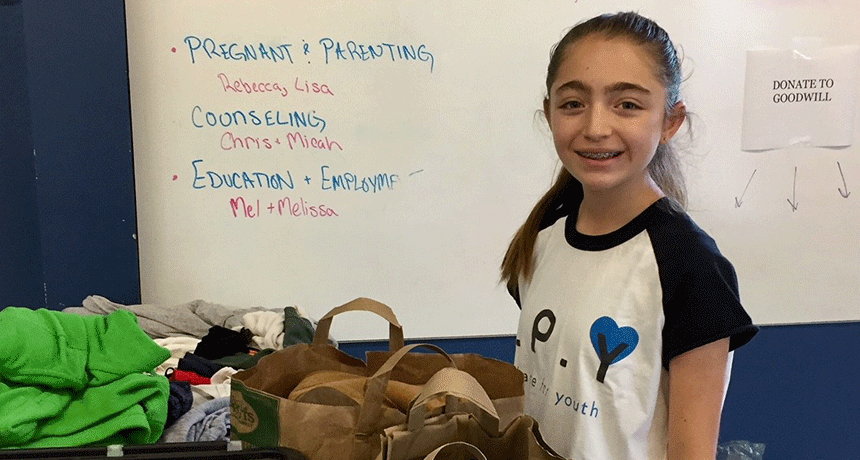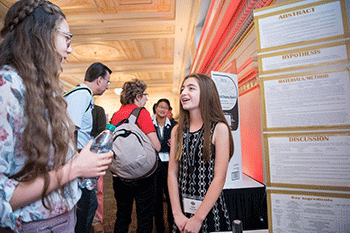Student invents 3-in-1 hygiene powder
It works as everything from a dry shampoo and body powder to toothpaste

Leia Gluckman volunteers at a homeless center. Her experiences inspired her to create a product that tackles several hygiene needs at once.
Gluckman
By Sid Perkins
WASHINGTON, D.C. — Homeless people face a lot of challenges. Among them: Not knowing where their next meal is coming from. Not having access to healthcare. Finding a job or getting a better-paying one. Some of the most basic challenges, however, stem from not having regular access to clean water and toiletries such as soap and shampoo. And poor personal hygiene can be particularly troubling for homeless teens. That challenge inspired a young researcher to invent a multi-purpose product — one that aims to give these teens a boost of confidence.
Leia Gluckman, 13, lives in Beverly Hills, Calif. “I was born into a life of volunteering,” she notes. And that’s almost literally true: Her mom is the vice president of an organization that provides help for homeless teens in the nearby city of Venice. Leia and her brother have volunteered there for years. When she was a toddler, Leia helped serve desserts at the tables where teens were eating. Later, she helped teens with art projects. Now, as a young teen herself, she’s hosting toiletry and clothing drives and tackling a variety of other chores.
From her work at the center, Leia noticed that teens asked for some hygiene products more than others. What they sought most often were toothpaste, body powder and shampoo. Leia wondered whether she might be able to create a product that could serve all three purposes.
It would need to absorb sweat and oil from skin and hair. It would need to clean teeth. Plus, it would need to kill bacteria without being harmful to people. She wanted her ingredients to be natural and biodegradable — and for the resulting product to taste and smell pleasant. And even that wasn’t the end of it. This product had to be low-cost and have a long shelf life. (That means it can’t spoil easily, even if not refrigerated.)

It wasn’t easy, but Leia came up with some prototype products. And she presented them here, October 21, at the finals of the Broadcom MASTERS science competition.
Broadcom MASTERS brings together 30 middle-school students each year for a special competition. (MASTERS stands for Math, Applied Science, Technology and Engineering for Rising Stars.) The program was created in 2011 by Society for Science & the Public, which publishes Science News for Students. The Broadcom Foundation of Irvine, Calif., sponsors the event.
Developing a recipe
Leia started by going to stores and looking at the ingredient lists for tooth powders, body powders and dry shampoos. Then she put together eight different trial recipes of her own. She tested each formula to see how well it absorbed body oil and cleaned hair. To gauge how these might work as a toothpaste, she tested them at removing coffee stains from eggshells.
Not all of Leia’s ingredients worked. Oat flour, for instance, clumped as it absorbed body oils. Lavender initially had a strong scent, but quickly faded.
Eventually, Leia settled on three working recipes. Each contains salt and baking powder. The salt acts as an abrasive. That helps it clean teeth and remove grime, she notes. Baking powder helps absorb odors. Her three recipes’ other ingredients differ. Some of those ingredients included cloves, cinnamon and chamomile (KAM-oh-meel). Those sorts of things give her products different tastes and smells. That would let teens choose a product based on personal preferences.
Leia wants to develop her products further. “Could it be used to repel mosquitoes?” she asks. “Or does it attract them? These are questions I want to answer next,” she notes.
Science offers a way to go about “solving problems and helping people,” says Leia. And she thinks her products could benefit a broad range of people, not just the homeless. Anyone in an area with little or no access to clean water could find her products useful, she says. That includes refugees as well as soldiers who are deployed to remote locations without running water.







